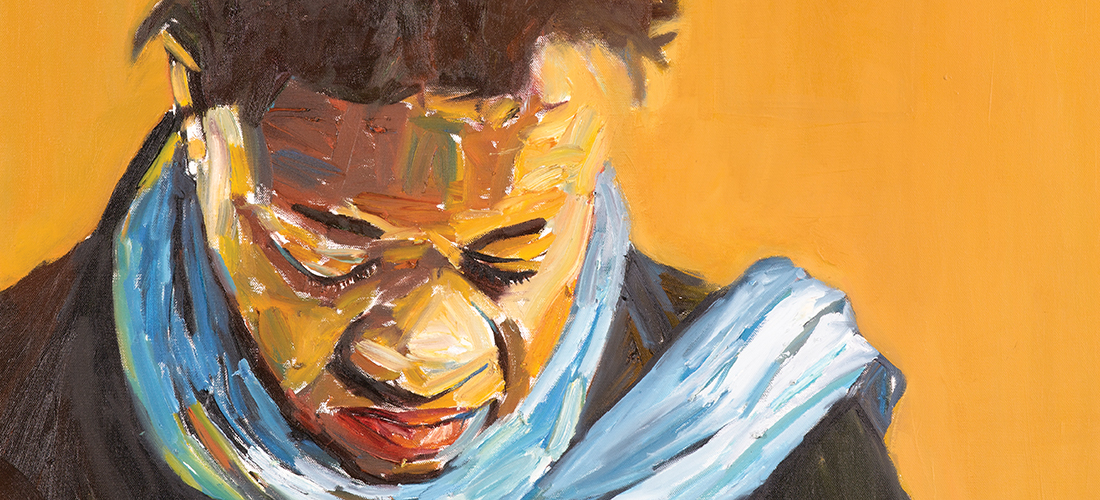
In darkness, Beverly McIver sees and paints by the light and voice of truth — and amazing grace
By Jim Moriarty
When I was much younger and more rambunctious my mother used to caution me that nothing good ever happens after midnight. My mother never knew Beverly McIver.
Working into the solitary small hours of the night, McIver often begins a canvas by projecting a face onto it. She underlines the eyes, the nose, the mouth, getting the drawing to her liking as if she were setting a table with the bare essentials before the feast. Then, when the light goes out, the paint goes on. And, oh my, does she paint. With a kaleidoscopic palette and audacious, yet economical, brush strokes, she steps into her subject — often not once, but over and over again, creating in the sweep of time a riveting series of canvases. Works can be built around a doll or a coil of black rope. They can be portraits of her mentally disabled sister, Renee, her father, Cardrew Davis, or even herself.
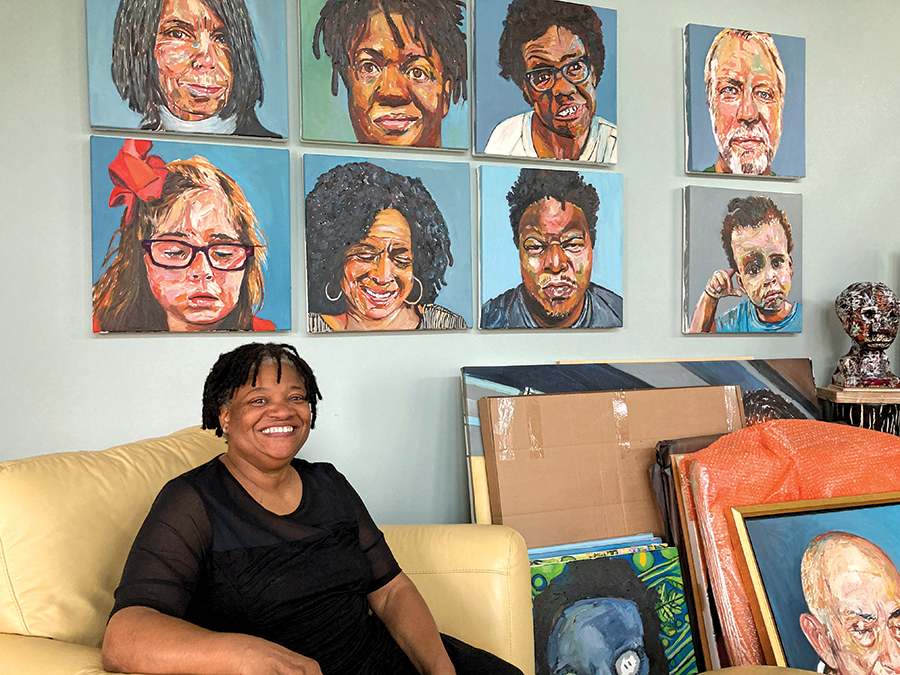
“The fact that she works in series is such a strength. And what I’m so moved by is the freshness, the fluency,” says Anne Brennan, the executive director of the Cameron Art Museum in Wilmington, North Carolina. “She must have a pact with herself about keeping it moving, keeping it fresh and not second-guessing. And, boy, she knows when to step back, when to get out. I think she trusts her intuition or subconscious. She’s paying attention. That is so brave. So brave and true to herself.” The Cameron is one of several museums — including the Mint Museum, the Crocker Art Museum, the Nasher Museum Art, the North Carolina Museum of Art, the Baltimore Museum of Art and the Scottsdale Museum of Contemporary Art — that hold McIver’s work in their permanent collections.
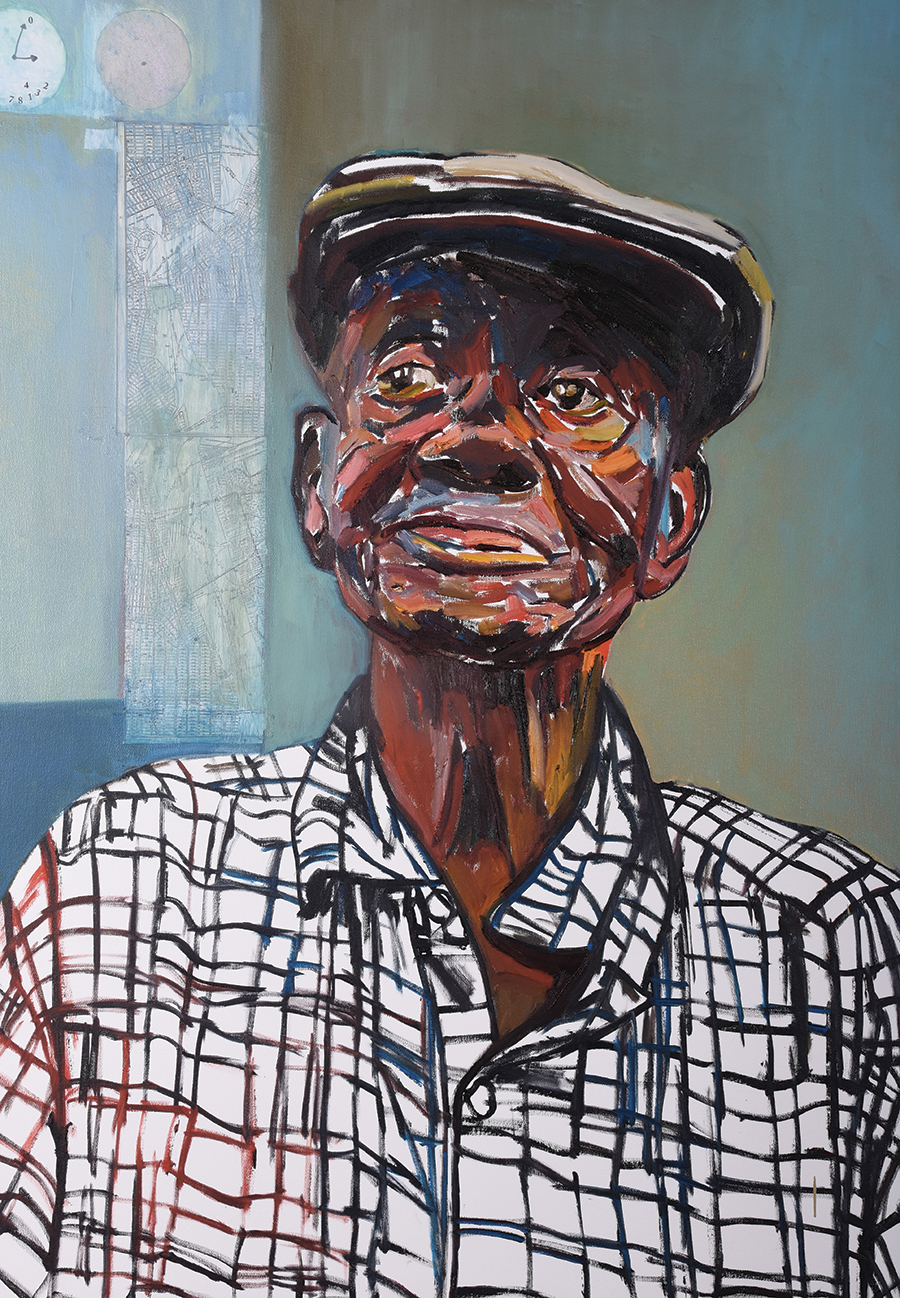
“Imagine if you were painting a series of self-portraits,” says Brennan. “Think how you might become formulaic in your choice of the passage of light against this plane of your face — and she is so not. Every painting is as fresh and innovative and original and spontaneous as the next.”
McIver’s magnetic laugh and her purring Persian cats — Clydie, Bona, Bella and Gracie — roam freely in her Hillsborough condo in the daytime. But, at night, she pays attention to the voice in her head. “They talk about artists needing natural light but when I’m painting I like for it to be dark,” says McIver, whose dreadlocks have fallen victim to a bit of pandemic-induced self-barbering.
“It’s quiet. My brain cuts on. That’s my authentic self. That’s the voice that I have no control over but to listen to it because it’s always right, even if I don’t really understand. My teacher in college said, ‘Just keep doing it. Don’t worry about what it is. Just keep walking.’ I said, ‘I don’t know what to do next.’ She’s like, ‘Just go there and wait for that voice. It’ll show up.’ I’ve always let that govern what comes out. It’s always way, way honest. Painfully honest.”
McIver grew up in Morningside Homes, barracks-style public housing a couple of miles east of downtown Greensboro, long since razed. It was the site of the 1979 “Greensboro Massacre” when members of the Klu Klux Klan and the American Nazi Party exchanged gunfire with protesters organized by the Communist Workers’ Party who had come to Greensboro in support of the region’s predominantly black textile workers. The “Death to the Klan” march was supposed to go all the way to city hall but the two groups clashed at the beginning of the march. Both sides exchanged gunfire. Five people were killed, four members of the CWP and Dr. Michael Nathan, the chief of pediatrics at Lincoln Community Health Center in Durham. The violent confrontation was captured on video, a slice of ‘70s history that plays on an eternal YouTube loop. McIver’s mother, Ethel, watched the shooting from her kitchen window. The family car, a lime-green Pinto, was shot in the gas cap, the bullet passing into the trunk. Ethel McIver testified at the trial of six members of the Klan, five charged with murder. All were acquitted. Beverly was 17. Though she was not a witness that Saturday morning — “I was working at McDonald’s on Battleground Avenue,” she says — she keeps a copy of her mother’s testimony.
The man who lent McIver her surname is barely a footnote in her life. “I have some tiny, tiny flashbacks of him putting us [Renee, the eldest, Roni, the middle sister, and Beverly, the baby] in a hot tub of water,” she says. “We were all crying because it was too hot. But that’s it.” He was gone by the time she was 3. When he passed away in New Jersey a decade or more later, the McIver family didn’t attend the funeral. A child of desegregation, Beverly was bussed across town to predominantly white schools. “In order just to exist I had to learn to straddle both of those worlds,” she says. One of the coping mechanisms she found was a clowning club at Grimsley High School. “As a clown,” McIver once told Kim Curry-Evans, now the director for Scottsdale Public Art in Arizona, “I was transformed, and in many ways more acceptable to society. No one cared that I was black or poor.” It was the seed of a theme featuring both whiteface and blackface that inhabits many of her canvases, particularly in her early works.
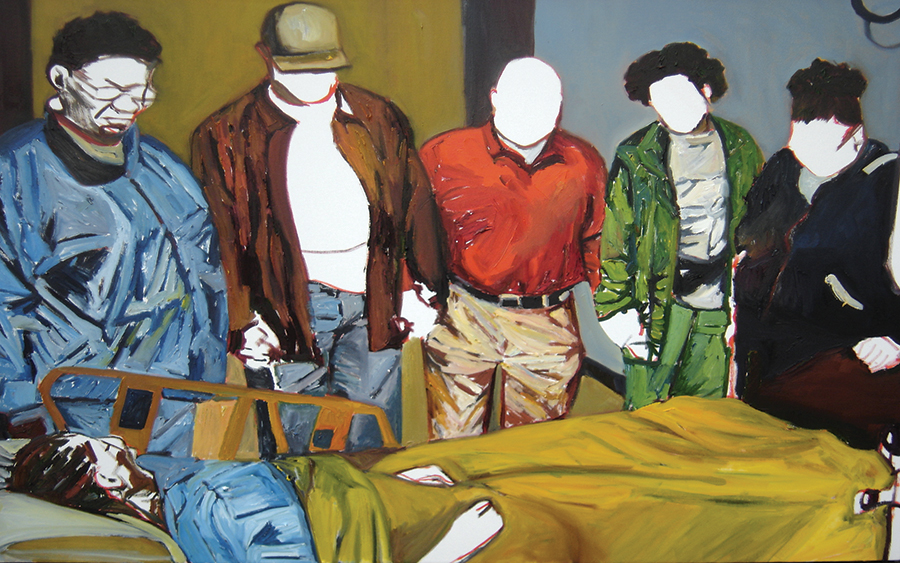
“I needed to not repeat living in the projects and being poor,” McIver says. “Whatever I do, I’m not interested in being poor again.” Her inner voice got louder when she squeezed her first tube of oil paint as an undergraduate at North Carolina Central University. “I had a great teacher who said to me, ‘You know, you have enough talent that if you work hard, you can make it.’ That’s all I needed to hear. I can make it.” The teacher’s name was Elizabeth “Libby” Lentz. She passed away in 2003. “I was in New York and got a call saying she’d driven up into the woods of North Carolina and left her car running and ran a hose from the exhaust into the car and the police had found her,” McIver says. “I flew back down to attend her service. It was horrible. It was really, really horrible. She was one of the first people that really believed in me, that I could have a voice to make a difference in the world. She was a painter and she taught me to paint. So, yeah, that was pretty sad.”
McIver’s degree from North Carolina Central was followed by a Master of Fine Arts from Penn State University and enough residencies, exhibitions (solo and group) and awards to make the curriculum vitae Hall of Fame. She’s held teaching positions at Arizona State University, NCCU and, for the last six years, Duke University. Though she’s set up her easel in places as disparate as an art colony in Saratoga Springs, New York, a studio in Brooklyn or an academy in Rome, her subjects are inevitably close to home.
McIver began painting her mentally disabled and epileptic older sister, Renee, 25 years ago and has never stopped. “I can paint Renee over and over again because she looks different. She looks like a little girl; she looks like she’s 70. Sometimes she looks fragile, like she’ll fall over. Renee is 60 now but has the mindset of a third grader,” says McIver. They talk on the phone every day. “I just ordered Renee a purple comforter. I saw her yesterday. She called me this morning. I said, ‘Renee, don’t call me before 11 o’clock.’ She called me at 10:15. I listened to the message. ‘Hey, I want you to know I really enjoyed that quiche you brought me yesterday. It was so good I ate two pieces this morning. I just wanted to let you know. I know you’re busy. I’m busy, too. I’m making potholders.’”
In 2002 when McIver was a Radcliffe Fellow at Harvard University, filmmaker Jeanne Jordan was a fellow at the same time — a fellow fellow, one supposes. “We were like across the hall from each other,” says McIver. One day Jordan told McIver that she and her husband, Steven Ascher, wanted to make a film about her. The result was the Emmy-nominated film Raising Renee. The initial idea for the project was to focus on McIver, her life and her art. But when her mother, Ethel McIver, was diagnosed with pancreatic cancer, “that changed everything,” says Beverly.
Ethel McMaster McIver grew up in Staley, North Carolina, near Liberty. “I think they went to Asheboro to shop at the Walmart,” says McIver. Ethel began cleaning houses when she was 10 years old, substituting for her mother one day when Beverly’s grandmother was too sick to go herself. Closeted in the Morningside Homes, it was a trade that lasted a lifetime. “When I got my first house I copied the furniture, all the things that were in one of the houses my mother cleaned, winged-back chairs and drop-leaf tables,” says Beverly. When Ethel passed away in March of 2004, Beverly became Renee’s primary caregiver. The film, six years in the making, began before Ethel’s death and ends when Renee is able to move into her own apartment. It tracks — in an unvarnished, authentic way — the complicated relationship between the artist and the sister who knits potholders by the bushel and is eternally enamored of the pinks and purples of a third grader. “I’m not going to pretend like it was easy or that I’m honored to be Renee’s legal guardian,” says Beverly. “I love Renee dearly but some people wanted a film more like glorifying caretaking in a way that’s just not true. Caretaking is hard. I don’t care who it is.”
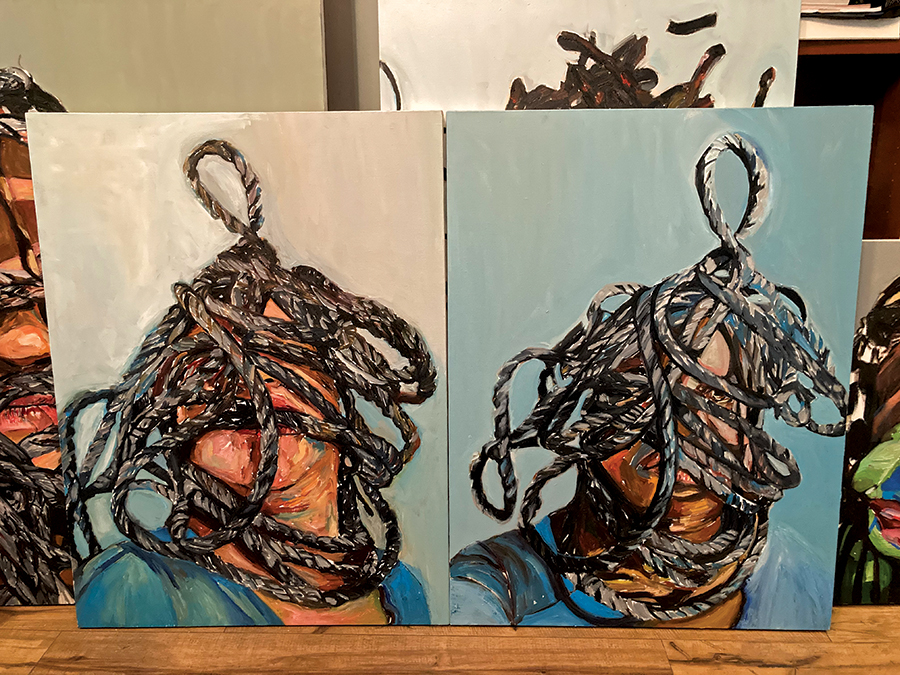
One of the works McIver painted during that period was Family Praying, a powerful image of five family members, holding hands around the hospital bed of their deceased mother, their own flesh whitened to the point where some features disappear completely. “They are in mourning, sort of life draining away, the way color might drain from someone’s face,” says Jennifer Dasal, the curator of Modern and Contemporary Art at the North Carolina Museum of Art and the host and creator of the acclaimed podcast ArtCurious. Seven years later, artistically admired and commercially comfortable, McIver made Truly Grateful, a self-portrait that’s currently paired in the NCMA exhibit “Interchanges: Cross-Collection Conversations” with The Virgin in Prayer by Giovanni Battista Salvi da Sassoferrato and Jesse Burke’s photo Blessed. McIver’s painting is described as exuding “a calming, almost spiritual atmosphere.” Even as color explodes on the surface of her canvases, McIver holds back nothing in revealing her subjects, including herself. “Maybe facial elements, things that might be blurred over by some artists trying to, perhaps, beautify somebody — she doesn’t do that,” says Dasal. “And I love that about her work. She’s aiming to show the truth about somebody.”
William Paul Thomas, a portrait painter himself and an adjunct professor of art at Guilford College, covered McIver’s classes at Duke while she was at the American Academy in Rome. “Her attention to the way light reflects off the surface of someone’s face is really fascinating,” says Thomas. “She achieves these really emotive, thoughtful, beautiful likenesses of her subjects with a kind of grace and economy. There’s a vibrancy and textural quality of paint that’s totally apparent when you see the work in person.”
And there is no telling where McIver’s voice might lead her. During her Covid confinement, it led to a piece of thick, black rope. “I have pictures of everybody with rope,” she says and laughs. What started out as a series about being stuck in the house turned into something more. “My intuition said to me, you need to buy rope. What do I need rope for? What am I going to do with rope? Then I said, ‘Well, let me see what rope costs on Amazon.’ The rope was, like, $30. If it had been a hundred I would have been, like, I’m not buying a hundred dollars worth of rope,” she says.
“I had no idea what I was going to do with it. So, thirty bucks, I ordered the rope. It was all coiled up and I pulled it apart and I was, like, I want to see what that looks like around my head,” she says, wrapping her arms around herself in the air. “It can look like an octopus. It can look like my hair before I had the Covid. My cousin, Lonnie, who lives in Greensboro was, like, ‘I got stopped by the cops again.’ He’s a tall black man, dark skinned. They pulled him over. They showed him a picture of the suspect.” She pauses. “OK, that does not make me feel better. I never thought of him as Black Lives Matter, I just think of him as my cousin Lonnie. I asked him if he would pose for me and I made this painting Lonnie Can’t Breathe.”
In August McIver joined a group of artists contributing works for the People For the American Way’s “Enough” campaign. The organization was founded by Norman Lear, someone McIver met once in New York at a party given by Maya Angelou in honor of Toni Morrison’s Pulitzer Prize. “I think I know Oprah, too, though I never met her,” Beverly jokes. McIver is simultaneously working on a solo exhibition for the Betty Cuningham Gallery, her New York affiliation, and curating an exhibit of African American artists for the Craven Allen Gallery in Durham, where she’ll also have a showing of her new paintings beginning Nov. 17. In 2022, she’ll have a traveling career “survey” that will begin at the Scottsdale Museum of Contemporary Art and travel to the Southeastern Center for Contemporary Art in Winston-Salem before going to the Gibbes Museum of Art in Charleston, South Carolina, among other possible locations. And she has long range plans to build a house on 11 acres in Chapel Hill where she’ll create an artist-in-residence program, aimed foremost at advancing artists of color. “I made some of my best work under those circumstances — when somebody is actually taking care of you and all you have to do is just paint. I want to be able to give that back,” she says.
The painting Taxi Driver is a relatively recent acquisition of the Cameron Art Museum. It’s among the paintings in what McIver calls her “Daddy Series.” She met her natural father, Cardrew Davis, when she was 16. “We were standing in the kitchen, me and my mother. ‘I have something to tell you.’ I said, ‘What?’ She said, ‘Yeah, your dad’s at the door.’ And there was this big guy standing there,” says McIver.
“I don’t know what the real story is. I know my mother wanted him to pull her out of that marriage. If you met my father you’d know that he’s incapable of that. He barely loves himself. When my mother died, he did attend the funeral. And that’s when I said, you know, I’m going to get to know this man.” She gave him one of her early portraits of him. When he found out it might be valuable he put it in the closet.
Another of McIver’s series features a tiny blackface, button-eyed doll. “She’s just a little black doll that my friend found online in an auction and purchased for me,” says McIver. “She’s been in a lot of my paintings.”
Actually, she’s been in all of them, from the ones painted in Rome to the ones created in Brooklyn to the ones that were not yet imagined by a little girl in hot water in Morningside Homes, who grew up working a 6 a.m. shift at Biscuitville and a cash register at McDonald’s. “There’s such a separation in my head from that little girl and who I am today,” says McIver, “to the point where I don’t think they recognize each other. So, Gracie — that’s my doll I’ve created — is sort of that little girl. I paint her.”
Oh my, does she paint. OH
When not spending time with his grandprincesses, Jim Moriarty is the senior editor of our sister publication, PineStraw magazine, in Southern Pines.





